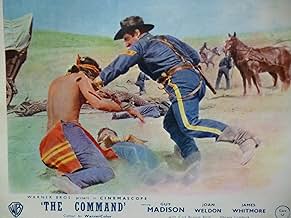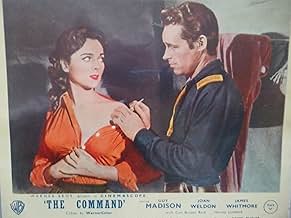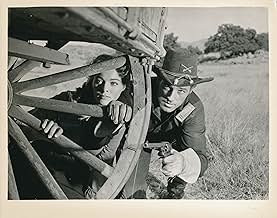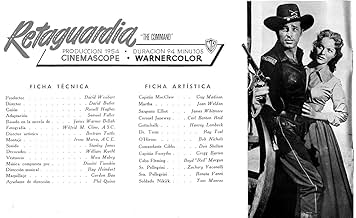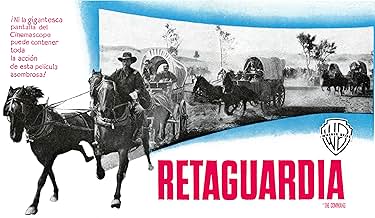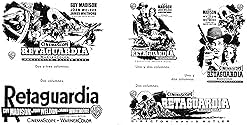IMDb RATING
6.4/10
689
YOUR RATING
An Army doctor with no combat experience is forced to take command of a cavalry troop escorting a wagon train through hostile Indian country when the unit's commanding officer dies.An Army doctor with no combat experience is forced to take command of a cavalry troop escorting a wagon train through hostile Indian country when the unit's commanding officer dies.An Army doctor with no combat experience is forced to take command of a cavalry troop escorting a wagon train through hostile Indian country when the unit's commanding officer dies.
- Director
- Writers
- Stars
Robert Nichols
- 2nd Lt. O'Hirons
- (as Bob Nichols)
Carl Andre
- Trooper
- (uncredited)
Emile Avery
- Outrider
- (uncredited)
Jim Bannon
- Infantryman
- (uncredited)
Gregg Barton
- Capt. Forsythe
- (uncredited)
George Bell
- Webb
- (uncredited)
John Beradino
- Sergeant Major
- (uncredited)
Richard Boyer
- Infantry Sergeant
- (uncredited)
Larry Chance
- Indian Brave
- (uncredited)
Mack Chandler
- Infantry Lieutenant
- (uncredited)
- Director
- Writers
- All cast & crew
- Production, box office & more at IMDbPro
Featured reviews
David Butler was the Warner Bros handyman director, as Robert Z Leonard was for Metro Goldwyn Mayer, or even Sidney Landfield for Twentieth Century Fox, directors more known for musicals, comedies, light hearted dramas, forgettable and lousy stuff, but once in a while a good, solid war drama, thriller or western. Leonard gave us THE BRIBE, starring Robert Taylor, Landfield HOUND OF THE BASKERVILLE, whilst David Butler made this excellent powerful western, plus KING RICHARD AND THE CRUSADERS, JUMP INTO HELL and SAN ANTONIO. Please forget the rest. Strange that in this western, you have a B movie cast, such as Guy Madison or Jim Withmore. The first Cinemascope western which looks like a blown up B picture. As also was CHARGE AT FEATHER RIVER, from thiis time a western specialist: Gordon Douglas. But taut and excellent.
10segstef
The good thing about this movie is the sympathy toward Native Americans. The Native Americans had no immunity to smallpox or chicken pox and no medicine to treat diseases. The main character played by Guy Madison constantly showed concern toward the Native Americans although he had to fight them. Although this movie had this social issue,it still had all the rousing entertainment of most calvary movies. The movie had a lot of saluting, which sometimes became a distraction. James Whitmore was great as the seasoned veteran just as he was in "Battleground". This movie had me wanting both sides to win.
Although I have never seen this movie, I am studying widescreen movies of the fifties and their influence on an audience beginning to be sated with the small screen, i.e. hypnotized by the cathode ray, i.e. tainted by TV!....This one has to be one of the first westerns to use this photographic process, later to be called Panavision. According to the Widescreenmuseum website, ''Broken Lance'' was made in '54, along with the "western" "& Brides for 7 Brothers"; ''Chief Crazy Horse'' was filmed in in '55, along with ''The Kentuckian'' and ''The Man from Laramie'' .... So I am gonna call it like I see it for now - All hail Sam Fuller!
A great Western that entertains well. It is a movie, along with "Charge at Feather River", where Guy Madison plays a character that though having to fight the Indians, also understands their situation.
The chemistry between Madison's and Whitmore's characters was very well played. It is well paced with story moments and action moments fitting together well.
As a historical note, the Winchesters used by the troopers were incorrect as props but then this was a 1950s Western when no one cared about those details. Spencer Carbines would have been correct but unavailable. The one interesting gun prop is in the scene where the scouts are chased back to the column and meet up with the Capt. and others. One of the troopers is obviously holding a Schofield revolver which though quite unusual, were used by the U.S. Cavalry in small numbers.
I really hope that this movie is released on DVD someday soon.
The chemistry between Madison's and Whitmore's characters was very well played. It is well paced with story moments and action moments fitting together well.
As a historical note, the Winchesters used by the troopers were incorrect as props but then this was a 1950s Western when no one cared about those details. Spencer Carbines would have been correct but unavailable. The one interesting gun prop is in the scene where the scouts are chased back to the column and meet up with the Capt. and others. One of the troopers is obviously holding a Schofield revolver which though quite unusual, were used by the U.S. Cavalry in small numbers.
I really hope that this movie is released on DVD someday soon.
After Captain Gregg Barton has been killed before dying he placed his troop of cavalry in the hands of the only officer left, army doctor Guy Madison. Madison is bringing them back to their fort when they meet up with a company of infantry and the wagon train they're escorting through Indian country. The short tempered Colonel Don Shelton, commandeers that same cavalry to help with the escort without knowing that Madison has no military training. The rest of the cavalrymen keep Madison's real army specialty a secret lest they spread some panic among the settlers.
Of course The Command that Madison is stuck with is no milk run. He's got to learn some real military tactics and has to learn them fast. Among the settlers there is an outbreak of what could be smallpox and Madison is hamstrung in giving aid in the profession he is trained in. Out of necessity he has to tell Joan Weldon who is traveling with the wagon train in the wagon where the sickness is starting.
The Command was one of the first film's done in the wide screen process with some 3D thrown in for good measure. With films on the big screen competing with the free small screen, gimmicks were thought to be needed to get the public out of their living rooms. A good solid cavalry western which The Command is was not enough at times.
James Whitmore as the sergeant who by rights should have been in charge and wisecracking Harvey Lembeck stand out in this cast. With a doctor hero and a cavalry setting, I'm surprised John Ford wasn't brought in for The Command. It seems like just his kind of material.
Of course The Command that Madison is stuck with is no milk run. He's got to learn some real military tactics and has to learn them fast. Among the settlers there is an outbreak of what could be smallpox and Madison is hamstrung in giving aid in the profession he is trained in. Out of necessity he has to tell Joan Weldon who is traveling with the wagon train in the wagon where the sickness is starting.
The Command was one of the first film's done in the wide screen process with some 3D thrown in for good measure. With films on the big screen competing with the free small screen, gimmicks were thought to be needed to get the public out of their living rooms. A good solid cavalry western which The Command is was not enough at times.
James Whitmore as the sergeant who by rights should have been in charge and wisecracking Harvey Lembeck stand out in this cast. With a doctor hero and a cavalry setting, I'm surprised John Ford wasn't brought in for The Command. It seems like just his kind of material.
Did you know
- TriviaAt about 79 minutes, in a scene of Indians attacking the wagons full of soldiers, one Indian gets shot off his horse, then is run over by a wagon drawn by four horses . That wasn't a planned stunt--he was supposed to be "shot" and fall off the side of his horse, but the horse unexpectedly reared back and dumped him into the path of the wagon, which ran over him. He suffered numerous broken bones and ribs, but the scene was left in.
- GoofsIn 1876 the single-shot Springfield Model 45-70 1873 rifle was the standard US Army infantry rifle, as identified by Captain MacClaw when he picks up an abandoned one. The cavalry used a single-shot carbine version of the Springfield 1873. Yet the final battle sequences show both the infantry and the cavalry troopers exclusively using Winchester or Henry style lever action repeating rifles, even though these weapons were never Army issue.
- Quotes
Sgt. Elliott: Never say an Injun is dumb. He just waits for the chance to use his one good cavalry tactic: ring around and close in.
- ConnectionsReferenced in Mademoiselle Porte-bonheur (1954)
- How long is The Command?Powered by Alexa
Details
Box office
- Gross US & Canada
- $2,500,000
- Runtime1 hour 34 minutes
Contribute to this page
Suggest an edit or add missing content

Top Gap
By what name was La poursuite dura sept jours (1954) officially released in India in English?
Answer
